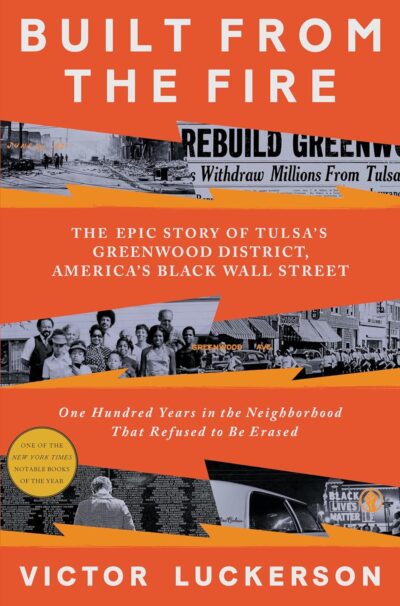Built From the Fire: The Epic Story of Tulsa’s Greenwood District, America’s Black Wall Street
By Victor Luckerson
Random House; 2023
Hardcover: $30
Genre: Nonfiction
Reviewed by Nancy Wilstach
This doorstop book is really worth tackling, guaranteed to answer questions you were not even sure you had but about which you suddenly find yourself bursting with curiosity. Luckerson tackles the heart-rending story of America’s “Black Wall Street”—from its gritty origins to its heyday of glitz, glamor, and gold through its mindless destruction by jealous, greedy white men and on to its partial revival as a Civil Rights emblem.
In May 1921, Greenwood Avenue in Tulsa, Okla., had everything a community needed—restaurants, bars, a movie theater, a bank, and a newspaper. It had a school, transportation, clothing and shoe stores. Black women didn’t have to buy clothes without trying them on, accept rudeness from salespeople, or use shabby separate entrances. No, Greenwood Avenue had it all, providing Black residents of Tulsa with courteous service, lavish entertainment, and appetizing food served with a smile.
Having heard for years about “Tulsa’s Black Wall Street,” I realized what I had gathered heretofore was merely a vague wisp of the real story. In today’s sad world of mass shootings and censored library books, what Luckerson has accomplished is to make us see a world of much greater danger—greater danger because the Black families and the businesses that lined Greenwood Avenue had come to feel safe enough to speak out against what they saw as an injustice.
The horrid overreaction of a horde of white men to Black people’s coming to the “white” side of town to stand up for a member of the Greenwood community brings a reader to anger and tears. Keep a tissue handy while you venture on with the determined Greenwood survivors as they raise a community from its ashes, rebuilding and repairing as they mourn as many as 300 friends and neighbors murdered by bigotry (and a strong measure of envy). The resulting community should have lived happily ever after, but life isn’t a fairy tale.
The Greenwood community now is cut in half by an interstate overpass thanks to the misnamed Urban Renewal of the 1960s. And today it faces the inroads of “gentrification” as high-rises encroach on Greenwood’s remnants.
However battered and bloodied by this history, the Black-owned Oklahoma Eagle, 100 years old in 2022, still publishes each week. There is some irony in the survival of this voice of Greenwood from the viewpoint of the thousands of print journalists either retired or doomed to produce clickbait by the widespread demise of print journalism.
Luckerson, himself a journalist, did not miss this thread through the tattered tapestry of Greenwood. The touchstone of his history of Greenwood is the Goodwin family and its ownership of the Eagle. It is still a family business, Luckerson tells us, while noting that these days Publisher Jim Goodwin devotes a major portion of his time to his law practice. A Goodwin also keeps Greenwood in the political mix: Regina Goodwin, a direct descendant of the first Goodwin publisher, serves in the Oklahoma legislature.
Nancy Wilstach is a writer and retired journalist in Montevallo, AL.






